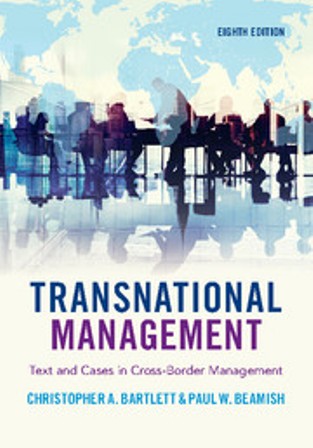Test Bank for Transnational Management Text and Cases in Cross-Border Management, 8th Edition Christopher A. Bartlett Paul W. Beamish
$35.00 Original price was: $35.00.$26.50Current price is: $26.50.
Test Bank for Transnational Management Text and Cases in Cross-Border Management, 8th Edition, Christopher A. Bartlett, Paul W. Beamish
Instant download Test Bank for Transnational Management Text and Cases in Cross-Border Management, 8th Edition, Christopher A. Bartlett, Paul W. Beamish pdf docx epub after payment.

Product details:
- ISBN-10 : 1108436692
- ISBN-13 : 978-1108436694
- Author: Christopher A. Bartlett; Paul W. Beamish
Transnational Management provides an integrated conceptual framework to guide students and instructors through the challenges facing today’s multinational enterprises. Through text narrative and cases, the authors skilfully examine the development of strategy, organizational capabilities, and management roles and responsibilities for operating in the global economy. The key concepts are developed in eight chapters that are supplemented by carefully selected practical case studies from world-leading case writers. All chapters have been revised and updated for this eighth edition to reflect the latest thinking in transnational management while retaining the book’s strong integrated conceptual framework. Ten new cases have been added, and four others updated. A full range of online support materials are available, including detailed case teaching notes, almost 200 PowerPoint slides, and a test bank. Suitable for MBA, executive education and senior undergraduate students studying international management, international business or global strategy courses, Transnational Management offers a uniquely global perspective on the subject.
Table of contents:
- Part I The Strategic Imperatives
- 1 Expanding Abroad: Motivations, Means, and Mentalities
- The MNE: Definition, Scope, and Influence
- Denition
- Scope
- MNE Inuence in the Global Economy
- The Motivations: Pushes and Pulls to Internationalize
- Traditional Motivations
- Emerging Motivations
- The Means of Internationalization: Prerequisites and Processes
- Prerequisites for Internationalization
- The Process of Internationalization
- The Evolving Mentality: International to Transnational
- International Mentality
- Multinational Mentality
- Global Mentality
- Transnational Mentality
- Concluding Comments
- Chapter 1 Recommended Practitioner Readings
- 2 Understanding the International Context: Responding to Conflicting Environmental Forces
- Forces for Global Integration and Coordination
- Forces of Change: Scale, Scope, and Factor Costs
- Forces of Change: Free Trade
- Driving an Expanding Spiral of Globalization
- Global Competitors as Change Agents
- Forces for Local Differentiation and Responsiveness
- Cultural Differences
- Government Demands
- Growing Pressures for Localization
- Forces for Worldwide Innovation and Learning
- Responding to the Diverse Forces Simultaneously
- Global, Multinational, and International Industries
- Transition to Transnationality
- Concluding Comments
- Chapter 2 Recommended Practitioner Readings
- 3 Developing Transnational Strategies: Building Layers of Competitive Advantage
- Worldwide Competitive Advantage: Goals and Means
- The Goals: Efficiency, Flexibility, and Learning
- Global Efficiency
- Multinational Flexibility
- Worldwide Learning
- The Means: National Differences, Scale, and Scope Economies
- National Differences
- Market potential varies across countries
- Scale Economies
- Scope Economies
- Mapping Ends and Means: Building Blocks for Worldwide Advantage
- International, Multinational, Global, and Transnational Strategies
- International Strategy
- Multinational Strategy
- Global Strategy
- Transnational Strategy
- Worldwide Competitive Advantage: The Strategic Tasks
- Defending Worldwide Dominance
- Challenging the Global Leader
- Protecting Domestic Niches
- Concluding Comments
- Chapter 3 Recommended Practitioner Readings
- Part II The Organizational Challenge
- 4 Developing a Transnational Organization: Managing Integration, Responsiveness, and Flexibility
- Beyond Structural Fit
- Challenges of the Matrix
- Building Organizational Capability
- Administrative Heritage
- Decentralized Federation
- Coordinated Federation
- Centralized Hub
- Administrative Heritage Meets Transnational Challenge
- The Transnational Organization
- Multidimensional Perspectives
- Distributed, Interdependent Capabilities
- Flexible Integrative Process
- Building a Transnational Organization: Beyond Structure
- Structuring the Organizational Anatomy
- Building the Organizational Physiology
- Developing the Organizational Psychology
- Managing the Process of Change
- The Transnational Organization in Transition
- Disenchantment with Formal Matrix Structures
- Redenition of Key Organization Dimensions
- Changing the Functional Management Role
- Concluding Comments
- Chapter 4 Recommended Practitioner Readings
- 5 Creating Worldwide Innovation and Learning: Exploiting Cross-Border Knowledge Management
- Traditional Innovation: Central and Local Models
- Making Central Innovations Effective
- Gaining Subsidiary Input: Multiple Linkages
- Responding to National Needs: Market Mechanisms
- Managing Responsibility Transfer: Personnel Flow
- Making Local Innovations Efficient
- Empowering Local Management
- Linking Local Managers to Corporate Decision-Making Processes
- Integrating Subsidiary Functions
- Transnational Innovation: Locally Leveraged, Globally Linked
- Making Transnational Processes Feasible
- From Symmetry to Differentiation
- From Dependence or Independence to Interdependence
- From Simple Control to Flexible Coordination
- Concluding Comments
- Chapter 5 Recommended Practitioner Readings
- 6 Engaging in Cross-Border Collaboration: Managing Across Corporate Boundaries
- Why Strategic Alliances?
- Technology Exchange
- Global Competition
- Industry Convergence
- Economies of Scale and Reduction of Risk
- Alliance as an Alternative to Merger
- The Risks and Costs of Collaboration
- The Risks of Competitive Collaboration
- The Cost of Strategic and Organizational Complexity
- Building and Managing Collaborative Ventures
- Building Cooperative Ventures
- Partner Selection: Strategic and Organizational Analysis
- Escalating Commitment: Thrill of the Chase
- Alliance Scope: Striving for Simplicity and Flexibility
- Managing Cooperative Ventures
- Managing the Boundary: Structuring the Interface
- Managing Knowledge Flows: Integrating the Interface
- Providing Strategic Direction: The Governance Structure
- Concluding Comments
- Easy – But Sometimes Not the Best Solution
- Alliances Need Not Be Permanent
- Flexibility is Key
- An Internal Knowledge Network: Basis for Learning
- Chapter 6 Recommended Practitioner Readings
- Part III The Managerial Implications
- 7 Building New Management Capabilities: Key to Effective Implementation
- Global Business Management
- Global Business Strategist
- Architect of Asset and Resource Conguration
- Cross-Border Coordinator
- Worldwide Functional Management
- Worldwide Intelligence Scanner
- Cross-Pollinator of ‘‘Best Practices’’
- Champion of Transnational Innovation
- Geographic Subsidiary Management
- Bicultural Interpreter
- National Defender and Advocate
- Frontline Implementer of Corporate Strategy
- Top-Level Corporate Management
- Providing Direction and Purpose
- Leveraging Corporate Performance
- Ensuring Continual Renewal
- Concluding Comments
- Chapter 7 Recommended Practitioner Readings
- 8 Shaping the Transnational’s Future: Defining an Evolving Global Role
- The Growing Discontent
- The Challenge Facing MNEs
- Responding to Developing World Needs: Four MNE Postures
- The Exploitative MNE: Taking Advantage of Disadvantage
- The Transactional MNE: Doing Deals, Respecting Laws
- The Responsive MNE: Making a Difference
- The Transformative MNE: Leading Broad Change
- Concluding Comments
- Chapter 8 Recommended Practitioner Readings
- Transnational Management Index (coded)
People also search:
Transnational Management Text and Cases in Cross-Border Management, 8th Edition
Transnational Management Text and Cases in Cross-Border Management, 8th Edition pdf
Transnational Management Text and Cases in Cross-Border Management
what is the difference between transnational and international crime
transnational media examples
what is transnational media
what are transnational crime











